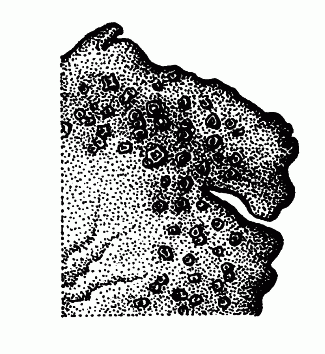Umbilicaria phaea Tuck.
Emery rocktripe
Umbilicariaceae
Introduction to the Lichens
Emery rocktripe
Umbilicariaceae
Introduction to the Lichens
Map
Distribution of Umbilicaria phaea unavailable
Species Information
General:
Common Name: The Rocktripe Lichens. Traditional, reflecting both the strict occurrence of the species over rock and (apparently) the use of certain species as food in times of famine.
Small to medium stratified foliose lichens, umbilicate, rotund to subrotund, corticate above and below, isidiate or more often not, thalloconidiate or not, lobes developed or not, thallus averaging to 0.5–7 (–15+) cm across, thin or occasionally thick. Upper surface greyish to dark brown. Lower surface tan, brown or black, naked or more or less covered in rhizines, plates and/or papillae. Medulla white. Photobiont green.
Apothecia located over upper surface, disc even or variously fissured or with central protruding button, black; spores simple or multi-celled, ellipsoid, colourless or occasionally brown, (1–) 8 per ascus.
Notes: Umbilicaria is primarily a boreal and arctic genus consisting of approximately 45 species worldwide. Of the 28 species known to occur in North America, 20 are reported for B.C. Earlier authors arranged the species listed below in as many as four genera — Actinogyra, Agyrophora, Omphalodiscus and Umbilicaria — though it is now customary to accommodate them in Umbilicaria. Strongly pustulate species, however, should be checked for in Lasallia. Gyrophoric acid (C+ red) is present in most Umbilicaria species, and norstictic and stictic acids also occur on occasion. Chemistry, however, is of little diagnostic value in this genus and is omitted.
Species description:
Isidia absent; lower surface naked or bearing plates or rhizines, pitted or not AND
Thallus distinctly foliose, attached to substrate by single, more or less central holdfast; upper surface occasionally perforate or segmented, but never chinky-cracked; distribution and ecology various AND
Lower surface (excluding rhizines) pale or brown or, if partly grading to black, then thalloconidia absent (i.e., lacking sharply demarcated black, sooty patches); apothecia usually abundant AND
Lower surface sometimes minutely textured, lacking rhizines and plates or at most bearing a few scattered cylindrical rhizines; lobe margins never rhizinate AND
\Lower surface distinctly and evenly grainy textured throughout, graininess readily observed with hand lens AND
Upper surface plane to pustulate-ridged or apparently chinky, never distinctly grainy textured, never white-pruinose; apothecia much-fissured; distribution various AND
Thallus periphery never abundantly and minutely perforate AND
Upper surface smooth or apparently chinky, never distinctly pustulate; thallus generally somewhat round in outline
Source: Lichens of British Columbia
Illustration

If more than one illustration is available for a species (e.g., separate illustrations were provided for two subspecies) then links to the separate images will be provided below. Note that individual subspecies or varietal illustrations are not always available.
Illustration By: Trevor Goward
Habitat and Range
Habitat: Frequent over rock in open sites at lower elevations, in semi-arid to dry intermontane localities, less common in maritime sites and probably absent from hypermaritime localitiesWorld Distribution: western N Am – eastern Eurasia, N to AK, S to MX.
Source: Lichens of British Columbia
Status Information
Synonyms
Synonyms and Alternate Names:
Gyrophora phaea (Tuck.) Nyl.